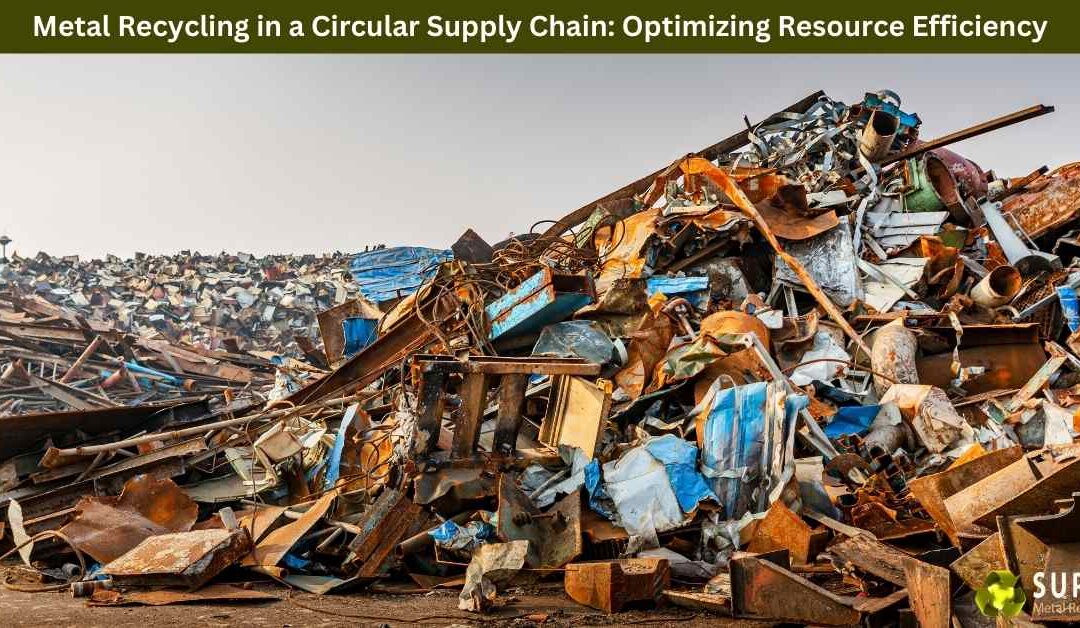As the world grapples with finite resources and increasing environmental challenges, the concept of a circular supply chain has emerged as a sustainable solution. Metal recycling plays a pivotal role in this model, ensuring that valuable materials are reused, reducing waste, and minimizing the need for raw material extraction. Let’s explore how metal recycling optimizes resource efficiency within a circular supply chain and why it is vital for a sustainable future.
Understanding the Circular Supply Chain
A circular supply chain focuses on creating a closed-loop system where materials are continuously reused and repurposed. Unlike the traditional linear model of “take, make, dispose,” the circular approach emphasizes:
- Reducing Waste: Designing products and systems to minimize waste.
- Reusing Materials: Extending the lifecycle of materials through refurbishment and repair.
- Recycling Resources: Converting waste into new raw materials for production.
In this framework, metal recycling is a cornerstone, enabling industries to conserve resources, lower environmental impact, and achieve greater sustainability.
The Role of Metal Recycling in a Circular Supply Chain
Metals, unlike many other materials, can be recycled indefinitely without losing their properties. This makes them ideal for a circular economy. Here’s how metal recycling contributes to a circular supply chain:
- Resource Conservation: Recycling metals like steel, aluminum, and copper reduces the need for mining, preserving natural resources and protecting ecosystems.
- Energy Efficiency: Producing metals from recycled materials requires significantly less energy compared to processing virgin ores. For example, recycling aluminum uses up to 95% less energy than primary production.
- Waste Reduction: By diverting scrap metal from landfills, recycling reduces environmental pollution and landfill overflows.
- Economic Value: Recycled metals retain their market value, providing cost-effective raw materials for manufacturers and supporting local economies.
Innovations in Metal Recycling
Advancements in technology are enhancing the efficiency and effectiveness of metal recycling processes. Key innovations include:
- Automated Sorting Systems: AI-powered machines and sensors can sort metals with high precision, reducing contamination and increasing the quality of recycled materials.
- Advanced Smelting Techniques: Modern smelting technologies enable the recovery of metals from complex waste streams, such as electronic waste.
- Decentralized Recycling Models: Mobile and community-based recycling units bring recycling facilities closer to waste sources, improving accessibility and participation.
Challenges and Opportunities
Despite its benefits, metal recycling faces several challenges within the circular supply chain:
- Material Complexity: Modern products often combine different metals and materials, making recycling more complicated.
- Quality Control: Ensuring that recycled metals meet industry standards requires advanced processing techniques and rigorous quality checks.
- Infrastructure Gaps: Limited recycling facilities and collection systems hinder the growth of metal recycling in some regions.
However, these challenges present opportunities for innovation, collaboration, and policy development. For instance, governments can introduce incentives for recycling, and businesses can invest in research and development to improve recycling technologies.
The Path Forward
To fully integrate metal recycling into a circular supply chain, stakeholders across industries must collaborate. Key strategies include:
- Design for Recycling: Manufacturers can design products with recycling in mind, using fewer composite materials and making components easier to disassemble.
- Public Awareness: Educating consumers about the importance of recycling and proper disposal practices can increase participation rates.
- Policy Support: Governments can implement regulations and incentives to promote recycling and discourage wasteful practices.
Conclusion
Metal recycling is a vital component of the circular supply chain, optimizing resource efficiency and reducing environmental impact. By embracing innovative technologies, addressing challenges, and fostering collaboration, we can create a sustainable system where metals are continuously reused. As industries and communities adopt circular practices, metal recycling will play an increasingly crucial role in building a greener and more resilient future.
If you are in Wheelers Hill, Victoria 3150, and looking for a metal recycling service, this is the best way to visit us.
Super Metal Recycling
345 Frankston – Dandenong Road, Dandenong South VIC 3175
(03) 9706 4909


Recent Comments